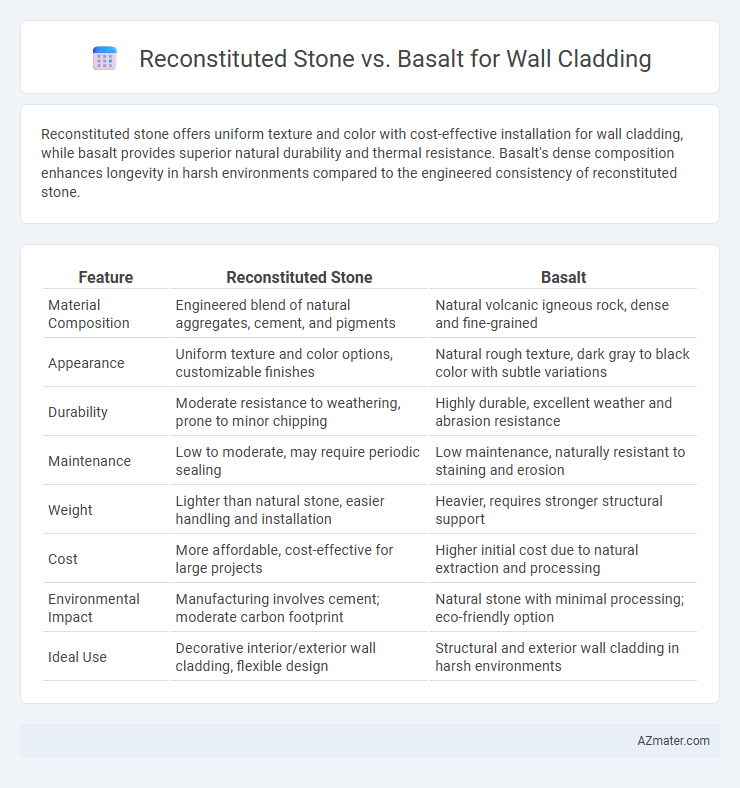Reconstituted stone offers uniform texture and color with cost-effective installation for wall cladding, while basalt provides superior natural durability and thermal resistance. Basalt's dense composition enhances longevity in harsh environments compared to the engineered consistency of reconstituted stone.
Table of Comparison
| Feature | Reconstituted Stone | Basalt |
|---|---|---|
| Material Composition | Engineered blend of natural aggregates, cement, and pigments | Natural volcanic igneous rock, dense and fine-grained |
| Appearance | Uniform texture and color options, customizable finishes | Natural rough texture, dark gray to black color with subtle variations |
| Durability | Moderate resistance to weathering, prone to minor chipping | Highly durable, excellent weather and abrasion resistance |
| Maintenance | Low to moderate, may require periodic sealing | Low maintenance, naturally resistant to staining and erosion |
| Weight | Lighter than natural stone, easier handling and installation | Heavier, requires stronger structural support |
| Cost | More affordable, cost-effective for large projects | Higher initial cost due to natural extraction and processing |
| Environmental Impact | Manufacturing involves cement; moderate carbon footprint | Natural stone with minimal processing; eco-friendly option |
| Ideal Use | Decorative interior/exterior wall cladding, flexible design | Structural and exterior wall cladding in harsh environments |
Introduction to Wall Cladding Materials
Wall cladding materials include a variety of natural and engineered options designed to enhance building aesthetics and durability. Reconstituted stone offers consistent texture and color uniformity by combining crushed natural stone with resin binders, making it lightweight and customizable. Basalt, a dense volcanic rock, provides exceptional strength and weather resistance, ideal for exterior wall cladding requiring high durability and natural stone appearance.
What is Reconstituted Stone?
Reconstituted stone is an engineered material made by combining crushed natural stone aggregates with binders such as cement or resin, designed to mimic the appearance and texture of natural stone. It offers greater design flexibility, consistent color, and uniformity compared to basalt, which is a dense, volcanic igneous rock known for its durability and natural variation. Reconstituted stone provides a cost-effective, lightweight alternative for wall cladding while maintaining aesthetic appeal similar to natural stone like basalt.
Understanding Basalt for Wall Cladding
Basalt is a natural volcanic rock known for its durability, density, and resistance to weathering, making it an excellent choice for wall cladding. Its fine-grained texture and rich dark color provide a modern, sleek appearance that enhances architectural aesthetics while ensuring long-lasting performance. Basalt's inherent thermal stability and low water absorption contribute to minimal maintenance needs and superior structural integrity in exterior cladding applications.
Aesthetic Differences: Reconstituted Stone vs Basalt
Reconstituted stone offers a uniform texture and color palette, allowing for consistent and customizable wall cladding designs, while basalt features natural variations in color and grain that create a more organic and rugged appearance. The smooth, polished finish of reconstituted stone contrasts with the typically rougher, matte surface of basalt, enhancing its rustic charm and tactile appeal. Basalt's unique veining patterns and mineral compositions provide dynamic visual interest that is difficult to replicate in reconstituted stone.
Durability and Strength Comparison
Reconstituted stone and basalt differ significantly in durability and strength for wall cladding applications. Basalt, a natural volcanic rock, offers exceptional compressive strength, high resistance to weathering, and superior durability, making it ideal for long-term exterior use. Reconstituted stone, composed of crushed natural stone bonded with cement or resin, provides good strength and versatility but generally does not match the longevity and robustness of basalt under harsh environmental conditions.
Installation Process: Reconstituted Stone vs Basalt
Reconstituted stone offers a lightweight and uniform material that simplifies the installation process for wall cladding, allowing for easier cutting, drilling, and fastening compared to basalt. Basalt, as a natural volcanic rock, is heavier and denser, requiring specialized tools, skilled labor, and extended installation times due to its hardness and irregularities. The adaptability of reconstituted stone reduces labor costs and installation time, making it a more efficient option for large-scale cladding projects compared to traditional basalt.
Maintenance and Longevity
Reconstituted stone offers enhanced resistance to weathering and requires less frequent sealing compared to basalt, making it a low-maintenance option for wall cladding. Basalt, prized for its natural durability and high density, provides exceptional longevity but may demand periodic cleaning to prevent moss and lichen buildup. Both materials excel in durability, but reconstituted stone's engineered composition allows for easier upkeep over time.
Cost Analysis and Budget Considerations
Reconstituted stone typically offers a lower initial cost compared to basalt, making it a more budget-friendly option for wall cladding projects with tight financial constraints. Basalt, a natural volcanic rock, commands a higher price due to its durability, density, and aesthetic appeal, often increasing overall project costs. When evaluating long-term expenses, reconstituted stone may require more maintenance and replacement, while basalt's longevity can lead to lower lifecycle costs despite the higher upfront investment.
Environmental Impact and Sustainability
Reconstituted stone, made from natural stone aggregates and eco-friendly binders, offers a lower environmental footprint compared to basalt, as it uses recycled materials and reduces quarrying impacts. Basalt, a natural volcanic rock, provides durability and thermal mass benefits but requires intensive mining and transportation, increasing carbon emissions. Choosing reconstituted stone promotes sustainability through resource efficiency and reduced waste, supporting green building certifications and reducing long-term ecological damage.
Best Applications: Choosing Between Reconstituted Stone and Basalt
Reconstituted stone offers versatility and cost-effectiveness, making it ideal for decorative wall cladding in residential and commercial interiors where customization and consistent texture are essential. Basalt, known for its durability and natural aesthetic, excels in exterior wall cladding applications exposed to harsh weather, providing superior resistance to erosion and structural integrity. Selecting between reconstituted stone and basalt depends primarily on the project's environmental exposure, budget constraints, and desired visual appeal.

Infographic: Reconstituted stone vs Basalt for Wall Cladding
 azmater.com
azmater.com